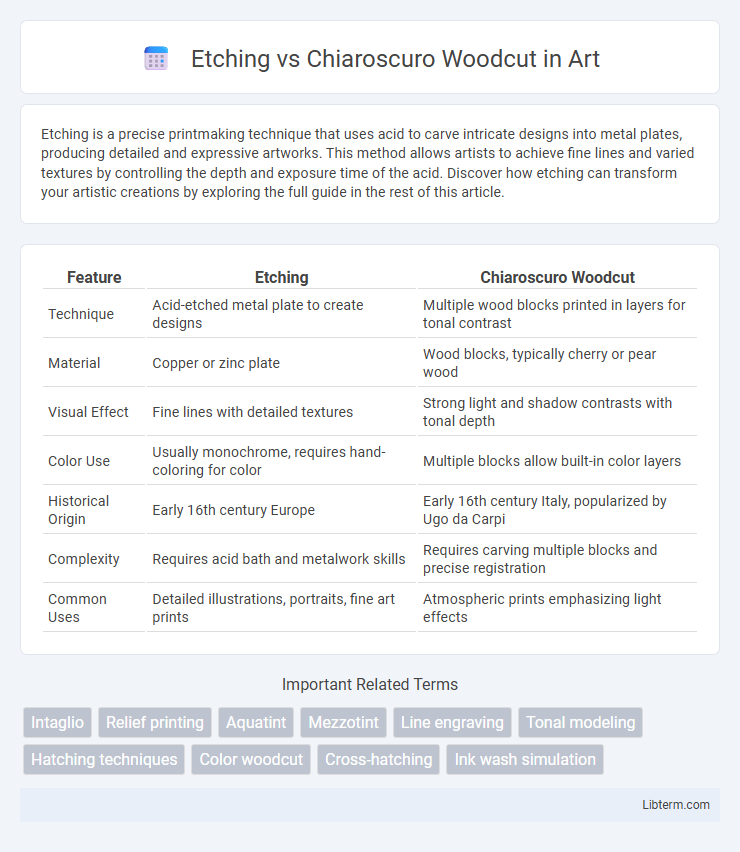Etching is a precise printmaking technique that uses acid to carve intricate designs into metal plates, producing detailed and expressive artworks. This method allows artists to achieve fine lines and varied textures by controlling the depth and exposure time of the acid. Discover how etching can transform your artistic creations by exploring the full guide in the rest of this article.
Table of Comparison
| Feature | Etching | Chiaroscuro Woodcut |
|---|---|---|
| Technique | Acid-etched metal plate to create designs | Multiple wood blocks printed in layers for tonal contrast |
| Material | Copper or zinc plate | Wood blocks, typically cherry or pear wood |
| Visual Effect | Fine lines with detailed textures | Strong light and shadow contrasts with tonal depth |
| Color Use | Usually monochrome, requires hand-coloring for color | Multiple blocks allow built-in color layers |
| Historical Origin | Early 16th century Europe | Early 16th century Italy, popularized by Ugo da Carpi |
| Complexity | Requires acid bath and metalwork skills | Requires carving multiple blocks and precise registration |
| Common Uses | Detailed illustrations, portraits, fine art prints | Atmospheric prints emphasizing light effects |
Introduction to Etching and Chiaroscuro Woodcut
Etching involves using acid to carve intricate designs into a metal plate, producing fine lines and detailed textures ideal for delicate artwork. Chiaroscuro woodcut utilizes multiple woodblocks to apply varying tones and shades, creating a rich contrast that emphasizes light and shadow in prints. Both techniques highlight different artistic approaches: etching favors line precision, while chiaroscuro woodcut emphasizes tonal depth and visual drama.
Historical Background of Printmaking Techniques
Etching originated in the early 16th century when artists used acid to create detailed images on metal plates, revolutionizing printmaking by allowing fine lines and intricate shading. Chiaroscuro woodcut developed slightly earlier, around the early 1500s in Germany and Italy, employing multiple woodblocks to produce tonal contrasts and mimic the effects of light and shadow. Both techniques significantly influenced Renaissance art, expanding the visual possibilities of prints and contributing to the dissemination of artistic styles across Europe.
Fundamental Principles of Etching
Etching relies on the principle of using acid to bite into a metal plate where the protective ground has been scratched away, creating lines that hold ink and produce printed images. The process involves coating the plate with a waxy ground, drawing the design with a needle, and submerging it in acid, which selectively corrodes the exposed metal. This technique allows for fine detail and subtle tonal variations unlike the high-contrast, layered approach characteristic of chiaroscuro woodcut.
Core Techniques in Chiaroscuro Woodcut
Chiaroscuro woodcut employs multiple woodblocks inked in different tones to create depth and contrast, enhancing the illusion of light and shadow within an image. Unlike etching, which uses acid to carve lines into a metal plate, chiaroscuro woodcut relies on precise hand-carving of layered blocks to achieve tonal variations. This technique emphasizes the interplay of light and dark, producing a richer, more dimensional visual effect in printmaking.
Materials and Tools Required
Etching requires a metal plate, typically copper or zinc, coated with an acid-resistant ground, along with etching needles and acid baths for incising designs. Chiaroscuro woodcut utilizes multiple wooden blocks carved to create tonal variations, combined with water-based inks and a press or baren for hand-printing. Both techniques demand distinct materials and tools that influence texture, detail, and shading in the final print.
Visual Aesthetic Differences
Etching produces fine, delicate lines with smooth tonal variations, resulting in images that often appear more detailed and nuanced compared to chiaroscuro woodcuts. Chiaroscuro woodcuts emphasize bold contrasts between light and dark areas using multiple woodblocks, creating a dramatic interplay of shadows and highlights that gives a sense of three-dimensionality. The etching technique favors subtle gradations and intricate textures, while chiaroscuro woodcuts rely on stark, layered color contrasts for visual depth.
Artistic and Cultural Impact
Etching and Chiaroscuro woodcut transformed printmaking by expanding artistic expression during the Renaissance and Baroque periods. Etching allowed artists like Rembrandt to achieve intricate details and tonal variations, influencing the development of fine art prints. Chiaroscuro woodcut introduced the use of multiple color blocks to create dramatic light and shadow effects, enriching visual storytelling and contributing to the evolution of color printing techniques.
Common Applications and Subjects
Etching and chiaroscuro woodcut both excel in producing intricate artistic prints, with etching commonly used for detailed, expressive line work in portraits, landscapes, and narrative scenes. Chiaroscuro woodcut is favored for its ability to render tonal variations through layered woodblocks, often employed in religious themes, classical mythology, and dramatic figure studies. Both techniques find frequent application in fine art printmaking, but etching is preferred for complex detail while chiaroscuro woodcut emphasizes light and shadow contrasts.
Pros and Cons of Each Technique
Etching offers precise line detail and allows for a wide range of tonal variation due to the chemical process of biting into metal plates, making it ideal for intricate designs but requiring extensive preparation and the use of hazardous acids. Chiaroscuro woodcut emphasizes contrast through layered blocks to create depth and shading, producing striking visual effects with fewer tonal gradations but demanding careful alignment and often limited detail compared to etching. While etching excels in fine detail and tonal subtlety, chiaroscuro woodcut provides bold, dramatic imagery with a more straightforward and safer printing process.
Choosing Between Etching and Chiaroscuro Woodcut
Choosing between etching and chiaroscuro woodcut depends on the desired visual effect and texture in printmaking. Etching offers fine, detailed lines with tonal variation achieved through acid-etched metal plates, ideal for intricate and expressive imagery. Chiaroscuro woodcut creates dramatic contrasts using multiple blocks to layer tones, emphasizing light and shadow for a painterly, textured appearance.
Etching Infographic

 libterm.com
libterm.com